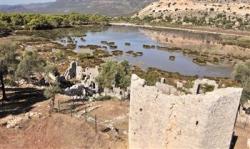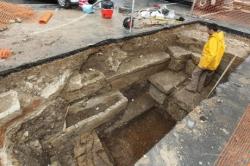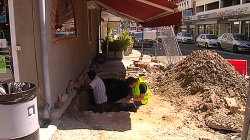INSTITUT SUPERIEUR D'ANTHROPOLOGIE
INSTITUTE OF ANTHROPOLOGY
ONLINE COURSES / COURS A DISTANCE
FALL TERM : OCTOBER 2013
REGISTER NOW
CHINE –  Guanghan -Thirty-eight ancient tombs and a rare half-naked figurine built in the Han Dynasty (202 BC - AD 220) were discovered recently in Guanghan, Sichuan province, Chengdu Commercial Daily reported on Friday.According to Liu Huashi, deputy director of the Sichuan provincial archaeology institute, the tombs have been excavated since June and were found over an area of more than 100,000 square meters. Although many of the tombs were robbed, archaeologists were able to unearth a number of rare relics from the tombs, including a figurine of a half-naked woman resembling the ancient Greek sculpture Venus de Milo. Liu said that the tombs are believed to have belonged to local rich people and officials and that the relics unearthed from the tombs will provide historical information about the region.
Guanghan -Thirty-eight ancient tombs and a rare half-naked figurine built in the Han Dynasty (202 BC - AD 220) were discovered recently in Guanghan, Sichuan province, Chengdu Commercial Daily reported on Friday.According to Liu Huashi, deputy director of the Sichuan provincial archaeology institute, the tombs have been excavated since June and were found over an area of more than 100,000 square meters. Although many of the tombs were robbed, archaeologists were able to unearth a number of rare relics from the tombs, including a figurine of a half-naked woman resembling the ancient Greek sculpture Venus de Milo. Liu said that the tombs are believed to have belonged to local rich people and officials and that the relics unearthed from the tombs will provide historical information about the region.
http://www.kaogu.cn/en/detail.asp?ProductID=4474
TURQUIE –  Andriake - The western part of the ancient city of Andriake, previously unattainable due to its remote location surrounded by trees and bush, has been unearthed and cleaned. The ancient city is five kilometers away from the southern province of Antalya’s Demre district and was one of the important Lycian ports.Archaeology teams have always worked in the eastern part of the ancient city and they cleaned the western part for the first time in September. Works unearthed the never-seen-before part of the ancient city. Works carried out under the leadership of the Antalya Museum restorer Serkan Akçay, lasted 30 days. Nine workers cut the bush and reeds and pruned the trees. The 300-meter-long and 50-meter-wide ancient city was revealed in the end of works, and arched structures, a church building and city walls from the Roman and Byzantine period came to light.
Andriake - The western part of the ancient city of Andriake, previously unattainable due to its remote location surrounded by trees and bush, has been unearthed and cleaned. The ancient city is five kilometers away from the southern province of Antalya’s Demre district and was one of the important Lycian ports.Archaeology teams have always worked in the eastern part of the ancient city and they cleaned the western part for the first time in September. Works unearthed the never-seen-before part of the ancient city. Works carried out under the leadership of the Antalya Museum restorer Serkan Akçay, lasted 30 days. Nine workers cut the bush and reeds and pruned the trees. The 300-meter-long and 50-meter-wide ancient city was revealed in the end of works, and arched structures, a church building and city walls from the Roman and Byzantine period came to light.
http://www.hurriyetdailynews.com/lost-city-in-forest-unearthed-in-antalyas-demre.aspx?pageID=238&nID=56221&NewsCatID=375
FRANCE –  Saint Front - En prévision des travaux autour de la cathédrale, plusieurs campagnes de sondages ont été menées depuis deux ans. Hier, Philippe Calmettes, de l’Institut de recherches et d’archéologie préventive (Inrap), présentait les résultats. Les fouilles du Thouin d’avril 2011 ont été « un peu décevantes », ne révélant que les bases de l’ancien évêché. Celles d’avril 2012, place de la Clautre, ont été passionnantes, en mettant au jour quatre niveaux de sépultures avec des sarcophages, des coffrages et des inhumations en pleine terre.À 3 mètres de profondeur, le sol originel a été découvert ainsi qu’un bout de mur du Bas Empire (IIIe -Ve siècle). La base de la fontaine de 1836 a aussi été retrouvée. Les premières inhumations remontent au Moyen Âge. On n’a quasiment pas mis au jour d’objets pour les datations (sauf quelques fragments de cuir) et il faudra attendre les analyses des ossements pour des résultats plus précis. La troisième campagne de sondages de l’Inrap, en février 2013 au Greffe, a aussi révélé des tombes.
Saint Front - En prévision des travaux autour de la cathédrale, plusieurs campagnes de sondages ont été menées depuis deux ans. Hier, Philippe Calmettes, de l’Institut de recherches et d’archéologie préventive (Inrap), présentait les résultats. Les fouilles du Thouin d’avril 2011 ont été « un peu décevantes », ne révélant que les bases de l’ancien évêché. Celles d’avril 2012, place de la Clautre, ont été passionnantes, en mettant au jour quatre niveaux de sépultures avec des sarcophages, des coffrages et des inhumations en pleine terre.À 3 mètres de profondeur, le sol originel a été découvert ainsi qu’un bout de mur du Bas Empire (IIIe -Ve siècle). La base de la fontaine de 1836 a aussi été retrouvée. Les premières inhumations remontent au Moyen Âge. On n’a quasiment pas mis au jour d’objets pour les datations (sauf quelques fragments de cuir) et il faudra attendre les analyses des ossements pour des résultats plus précis. La troisième campagne de sondages de l’Inrap, en février 2013 au Greffe, a aussi révélé des tombes.
http://www.sudouest.fr/2013/10/14/les-secrets-de-saint-front-1198284-1951.php
NOUVELLE CALEDONIE –  Nouméa - Les travaux d'aménagement de la mairie de Nouméa au quartier latin ont réservé une belle surprise: une citerne d'eau, datant du début du XX ème siècle, enfouie sous la terrasse d'un restaurant.Des citernes, les archéologues en ont déjà trouvées à Nouville près des vestiges du bagne ou encore à Fort Teremba. Cette fois-ci, c'est en plein coeur de Nouméa, au quartier latin, qu'une citerne construite en briques a été découverte. Au tournant du XX ème siècle, ces cuves étaient essentielles à l'alimentation en eau pour les populations. Les équipes de l'Institut d'Archéologie de la Nouvelle-Calédonie et du Pacifique se sont rendues sur place en urgence pour effectuer les premiers relevés. Une façon de se souvenir d'une partie de l'histoire calédonienne.
Nouméa - Les travaux d'aménagement de la mairie de Nouméa au quartier latin ont réservé une belle surprise: une citerne d'eau, datant du début du XX ème siècle, enfouie sous la terrasse d'un restaurant.Des citernes, les archéologues en ont déjà trouvées à Nouville près des vestiges du bagne ou encore à Fort Teremba. Cette fois-ci, c'est en plein coeur de Nouméa, au quartier latin, qu'une citerne construite en briques a été découverte. Au tournant du XX ème siècle, ces cuves étaient essentielles à l'alimentation en eau pour les populations. Les équipes de l'Institut d'Archéologie de la Nouvelle-Calédonie et du Pacifique se sont rendues sur place en urgence pour effectuer les premiers relevés. Une façon de se souvenir d'une partie de l'histoire calédonienne.
http://nouvellecaledonie.la1ere.fr/2013/10/08/decouverte-archeologique-au-quartier-latin-75433.html
FRANCE – Cahors - Le projet de construction d’un hôtel sur un site archéologique à Cahors, agite la paisible Société des études du Lot.Les fouilles préventives conduites en 2011 par l’Inrap (Institut national de recherches archéologiques préventives) ont révélé des dessous intéressants. Didier Rigal, archéologue lui-même et membre de l’association, décrypte les premiers sondages. «Mon collègue est intervenu sur environ 10 % du terrain, dont la superficie est de 4 000 m2. Ces sondages ont démontré la présence de murs solides jusqu’à 2 m de fondation, de plusieurs absides, d’éléments de placage en marbre, le tout donnant l’assurance d’avoir là les vestiges d’un monument en liaison avec l’eau», assure Didier Rigal. L’archéologue échafaude deux hypothèses : «Le site pourrait être celui d’un ensemble thermal datant du tout début du Ier siècle de notre ère, ou bien alors un temple dans lequel on vénérait Divona». Un potentiel archéologique qui n’a pas pour autant décidé la Drac (le service régional d’archéologie) de déclencher l’ouverture de fouilles de sauvetage, comme cela avait été le cas lors de la construction du parking souterrain de l’Amphithéâtre. La société des études du Lot le regrette : «l’opération pourrait être relativement rapide, environ deux à trois mois de fouilles», avance Didier Rigal.
http://www.ladepeche.fr/article/2013/10/12/1729705-cahors-le-futur-hotel-sur-un-site-archeologique.html
SUISSE -  For centuries it was believed that Leonardo da Vinci made a pencil sketch of Isabella d’Este, but that he never completed a full portrait of the famous Renaissance noblewoman. Now, a discovery in a bank vault in Switzerland has revealed that the Italian art master likely did do a finished piece. The painting has been part of a private collection of 400 works owned by an Italian family and kept in a Swiss bank. Experts have now looked and tested the portrait, which measures 24 inches by 18 inches and was painted canvas, and believe that da Vinci created it. “There are no doubts that the portrait is the work of Leonardo,” says Carlos Pedretti, a professor emeritus of art history professor at the University of California Los Angeles. “I can immediately recognise Da Vinci’s handiwork, particularly in the woman’s face”. According to the Italian newspaper Corriere della Sera, the University of Arizona conducted carbon dating tests that revealed with 95 percent accuracy that the artwork was painted sometime between 1460 and 1650. Other tests have shown that the type of pigment in the portrait was the same as that used by Leonardo, as was the primer used to treat the canvas. Leonardo da Vinci met Isabella d’Esta, Marchesa of Mantua in either 1499 or 1500, and made a pencil sketch of her. The Marchesa, one of the most prominent noblewomen of the Renaissance and a rival to Lucrezia Borgia, was pleased with the drawing and sent letters to da Vinci asking for a full portrait to be done. Art historians had believed that the the artist was never able to paint the full version. There are only about 15 confirmed Leonardo da Vinci paintings known to exist.
For centuries it was believed that Leonardo da Vinci made a pencil sketch of Isabella d’Este, but that he never completed a full portrait of the famous Renaissance noblewoman. Now, a discovery in a bank vault in Switzerland has revealed that the Italian art master likely did do a finished piece. The painting has been part of a private collection of 400 works owned by an Italian family and kept in a Swiss bank. Experts have now looked and tested the portrait, which measures 24 inches by 18 inches and was painted canvas, and believe that da Vinci created it. “There are no doubts that the portrait is the work of Leonardo,” says Carlos Pedretti, a professor emeritus of art history professor at the University of California Los Angeles. “I can immediately recognise Da Vinci’s handiwork, particularly in the woman’s face”. According to the Italian newspaper Corriere della Sera, the University of Arizona conducted carbon dating tests that revealed with 95 percent accuracy that the artwork was painted sometime between 1460 and 1650. Other tests have shown that the type of pigment in the portrait was the same as that used by Leonardo, as was the primer used to treat the canvas. Leonardo da Vinci met Isabella d’Esta, Marchesa of Mantua in either 1499 or 1500, and made a pencil sketch of her. The Marchesa, one of the most prominent noblewomen of the Renaissance and a rival to Lucrezia Borgia, was pleased with the drawing and sent letters to da Vinci asking for a full portrait to be done. Art historians had believed that the the artist was never able to paint the full version. There are only about 15 confirmed Leonardo da Vinci paintings known to exist.
http://www.archaiologia.gr/en/blog/2013/10/15/leonardo-da-vinci-painting-discovered-in-swiss-bank-vault/